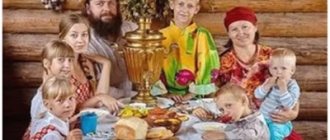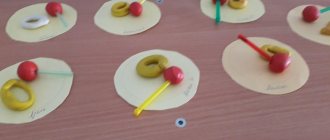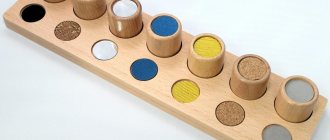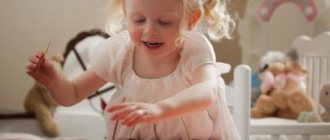“Teddy bear in kindergarten”: final lesson on sensory skills
- February 9, 2014
Competition “My Pedagogical Initiative - 2013”
Nomination “Methodological work in preschool educational institutions”
In their centuries-old practice, people have created certain standards of shapes, sizes, and color tones. The child needs to master these standards and receive, as it were, a set of standards with which he can compare any newly perceived property of an object and give it a proper definition.
In life, a child encounters a variety of shapes, colors and other properties of objects. It is still very difficult for him to understand all this diversity, and he needs the help of adults. The teacher organizes the child’s sensory experience using a certain social experience. The accumulation of sensory representations involves familiarization with color, shape, and size.
Educational areas: Cognition, communication, socialization.
Types of children's activities: speech, play, motor.
Program content:
- continue to teach children logical thinking using the siriation method (correct assembly of the pyramid);
- find a pair based on two characteristics (large - small and color);
- consolidate knowledge of colors (red, blue, yellow, green);
- Strengthen children's knowledge about wild animals (bear);
- cultivate a friendly attitude between peers, a desire to help each other;
- consolidate children's knowledge about parts of their body.
Goal : to consolidate children’s knowledge of color, shape, size.
Equipment : teddy bear, pyramid, ball, basket with mushrooms, cut-out pictures, dishes.
Participants : children of the 1st junior group, teacher.
Progress of the lesson
Children enter the group and see pyramid rings scattered on the floor.
Educator: Ay - ah - ah, who scattered the toys?
A teddy bear sits on a chair.
Educator: Bear, were you the one who scattered the toys around the group?
Bear: Yes, I came to visit you and played a little.
Educator: Guys, is it possible to behave like this when visiting? (Children's answers).
Bear: forgive me, I won’t do that again.
Educator: Bear, since you understand that this is bad, then assemble a pyramid, and the guys will help you, you just need to assemble it correctly, first the large rings, then the smaller ones.
Children collect rings throughout the group. The teacher holds a rod on which rings are strung. As the pyramid is collected, the teacher specifies the color, size and shape of the ring. When the pyramid is assembled, the teacher praises the children. Mishka thanks the children for their help and invites them to play the game “Let’s get to know each other.” The children stand in a circle, Mishka throws the ball to them in turn, and the children say their name.
Bear: I slept in my den all winter, and spring came, I woke up and decided to come to visit you and play. Do you know where I live?
Children: In the forest!
Bear: That's right, do you know who else lives in the forest? (Children's answers). My friend Squirrel gave you gifts from her supplies, look, what are they?
Shows the children a basket of mushrooms. The bear randomly scatters mushrooms on the floor.
Bear: Oh, guys, can you help me collect mushrooms?
Children: Yes!
Children collect mushrooms, the teacher specifies what they are (what color, size, hard or soft).
Educator: Guys, let's also give Mishka a gift, we'll treat him with delicious and sweet berries.
The didactic game “Cut Pictures” is being played.
Bear: Thank you guys, you are so good!
The teacher invites the children to recite A. Barto’s poem “Bear”.
Bear: Oh, guys, show me where my paw is? Eyes? Ears? Nose?
Educator: Mishka, don’t you know the parts of your body at all? The guys and I will help you!
A physical session “Studying our body” is being held:
One, two, three, four, five - let's study the body! Here is the back, and here is the tummy, arms, legs, eyes, nose, mouth, ears, head - I barely managed to shake it. Neck - turns her head, oh, tired oh - oh - oh! The forehead and eyebrows, and the eyelashes, fluttered like birds. Pink cheeks, bumpy chin. The hair is thick, like meadow grass. Shoulders, elbows and knees. With me, Seryozha, Lena!
Bear: Thank you guys, you taught me a lot today.
Educator: Children, what did we teach Mishka today? (Children's answers).
The teacher invites the children to treat Mishka to tea, but the cups on the table are mixed up. I will give you saucers, and you match them with cups of the same color and size.
The didactic game “Find a Pair” is being played.
Children treat the bear with tea.
List of sources used:
Wenger L.A., Pilyugina E.G., Wenger N.B. Nurturing a child’s sensory culture.
Author: Evgenia Mikhailovna Vedrentseva, teacher of the Suzun kindergarten No. 2, working village of Suzun, Novosibirsk region. Teaching experience 2 years.
Summary of open GCD on sensory in the first junior group “Colorful balls”
Summary of open GCD on sensory in the first junior group “Colorful balls”
Goal: to develop in children an interest in learning and a desire to help in a difficult situation. Objectives: Educational: 1. Develop the ability to group objects by color. 2. Strengthen the ability to distinguish between “this”, “not like this”, “many”, “few”, “same in color”, “different in color”, consolidate knowledge of geometric shapes. 3. Introducing the color yellow. 4. Encourage children to name objects. Educational: 1. Foster independence, activity, and the ability to work in a team. Vocabulary work: yellow, like this, not like that, identical, different, big, small. Materials: Katya doll, magnetic board, magnets of different colors (red, blue, green, yellow, flowers cut out in different colors (red, blue, green, yellow, butterflies on a string (red, blue, green, yellow), artificial grass, path with sewn buttons, ribbed board, illustrations - chicken, sun, banana, lemon - yellow. Envelope. Progress of the lesson: Children take off their sandals and enter the group in socks. Q: children, today we have guests, let's say hello to them. D : hello. Q: now let's say hello to each other. Turn your head to the window, smile at the neighbor on the left. Now turn your head in the other direction and smile at the neighbor on the right. And I greet you too: hello, children! D: hello, Nadezhda Viktorovna . Q: (shows the envelope, guys, today we received this letter. Katya the doll is very upset, something happened to her. We have to help her. Shall we help? D: yessss! Q: then let's immediately go to visit Katya and Let's find out what happened to her. Look, we need to go along three paths to get to Katya. Let's hit the road. First we walk along the “grass”. Top-top-top, little legs, walking along the path. And now we are walking along the “pebbles” (path with buttons). What a great fellow you are, you overcome a long journey very well. And now we just have to go through the small hills (ribbed board). You guys are great, we got to Katya very quickly and covered a difficult path. Here we are. (a Katya doll is sitting on a chair, “crying”, with a box with magnets of different colors). Nearby there is a magnetic board, on it the outlines of balls are drawn with different markers (red, blue, green and yellow) Q: Katyusha, what happened to you, why are you crying? K: Guys, I drew balls and wanted to decorate them with magnets, but the window opened and a breeze blew and the magnets all scattered. I'm so upset that now I can't sort them by color. Guys, can you help me decorate the balloons again? D: we’ll help. Children take magnets and arrange them by color. Q: Guys, look, what color magnets will we put in the red outline of the ball? D: red. Q: correct, and in the blue outline? D: blue. Q: You guys are great to me. Tell me please, what shape are our balls? D: oval shape. B: Well done. Please note, do we have many or few magnets? D: a lot. Q: What about the balls? D: not enough. Q: Guys, look, we still have one balloon left undecorated. Do you know what color this is? D: no. Q: We are not familiar with this color yet. Now I will introduce you to a new color, it is a very cheerful and warm color. And it's called yellow. Let's do it all again together. D: yellow. Q: (shows illustrations, guys, what color can we have that is yellow? Let’s look at the picture. A chicken can be yellow. We repeat together - a yellow chicken. D: a yellow chicken. Q: the sun that shines and warms us is yellow , look (picture)
We repeat. D: yellow sun. Q: Bananas are also yellow, do all children like bananas? We repeat. Yellow banana. D: yellow banana. Q: What is this? D: lemon. B: correct. Now can you tell me what color the lemon is? D yellow. Q: Correct. So we introduced you to the color yellow. But these are not the only objects that can be yellow. There are still many, many different yellow objects in the world, and we will gradually get to know them. Now take the yellow magnets and decorate the yellow ball. D: do. Q: Look, Katyusha is very happy, she smiles and says thank you. We completed the task, did we help Katya? D: yeah! Q: We need to go back, let's take Katya with us and play with her. D: ok. They return back along the same path. Saying the famous song: the king walked through the forest, through the forest, through the forest. The king found the princess, princess, princess. (physical minute, let’s jump, jump, jump. And we’ll jump with our legs, we’ll jump, we’ll jump. And we’ll clap, clap, clap with our hands. And we’ll stomp, stomp, stomp with our legs. Q: so we came back. Guys, our Katya really loves to play with butterflies, let's go to the clearing and look for butterflies. D: yeah! (Flowers are laid out on them with butterflies of the same color). Children are looking for butterflies, they see flowers, but the butterflies are not noticeable. Q: guys, look carefully, where are the butterflies hiding? D : they notice butterflies on flowers. Q: children, why do you think we didn’t see butterflies right away? D: they think. Q: Because butterflies are the same color as flowers. We repeat together. D: the same color as and flowers. Q: You can also say the same color. Now look, if you put a green butterfly on a yellow flower, will it be visible? D: Yesss. Q And why? Because the butterfly is not the same color as the flower. We repeat together. D: not the same color. Q: you can also say different in color. We repeat. D: different in color. Q: I noticed something else. Our flowers are big, but what about butterflies? D: small. B: correct. Let's say it together. D: the flowers are big and the butterflies are small. Now let's play with butterflies. We'll take them by the string and blow on them and see how they fly. Only we must follow the rule of how to blow correctly. Let me remind you: inhale through your nose and exhale through your mouth. D: blow on butterflies. Q6 Which flower will a blue butterfly fly to, like Semyon’s? D: to blue. B: correct. And Ksyushina’s red butterfly will fly to which flower? D: to red. B: Well done. And if a butterfly lands on a flower of a different color, it can be easily seen and may die. That’s why butterflies hide from their enemies like this. Look, Katyusha likes to play with butterflies. Our lesson is over, thanks guys. You did a great job today. What new color did we learn today? D: yellow. B: Well done! What did we help Katya do? D: decorate the balls. Q: Thanks guys. If you want, you can also play with the butterflies.



